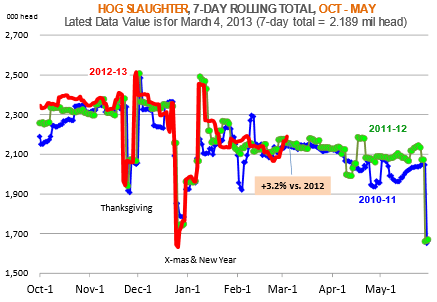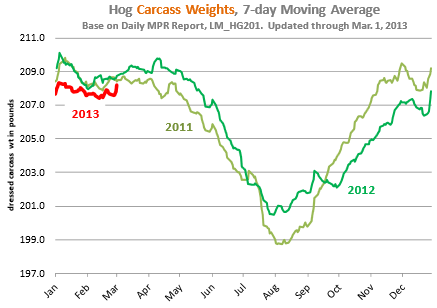



CME: State of Pork Demand Raises Questions
US - Hog futures traded lower on Tuesday on weak wholesale prices and reports of producers becoming more aggressive in their marketings, write Steve Meyer and Len Steiner.Hog slaughter picked up last week and the seven day total (through March 4) stood at 2.189 million head, 1.7 per cent higher than the same period a year ago. The expectation is for hog slaughter to drift lower into April but futures at this point have removed all the normal seasonal premiums. April lean hog futures closed last night at $80.300/cwt, 83 points lower than the previous close and about $10/cwt lower compared to where prices stood at the end of January.
April lean hog futures are now trading at a discount to current cash IA/MN prices. The expectation is for slaughter to hover near or even slightly below year ago levels through the end of March and into April. If producers are indeed pulling marketings forward, we could see April slaughter decline compared to year ago levels. Hog weights continue to track below last year’s levels, an indication that producers remain relatively current in their marketings.
If anything, more aggressive marketings will continue to limit hog carcass weight gains. The latest data from the MPR report (we use a 7-day average of LM_HG201) shows hog carcass weights at 208 pounds per carcass, 0.4 per cent below year ago levels.


While hog supplies do not appear burdensome compared to year ago levels, the big question going into the spring remains the state of pork demand . For US pork, export demand is particularly important, with almost 1 out of 4 pounds of pork going to other markets. Russia has now completely closed its market to US beef and pork while China requires that a third party verify that US pork is free of ractopamine.
Losing sales to the lucrative Russian market is significant as product now has to be sold at a discount to other markets or sold at lower prices through domestic channels. Reduced product flow to China because of the increased testing also has negatively impacted pricing for items that traditionally go to these markets. Russia used to be a big buyer of US hams and frozen pork trimmings while China accounted for about a third of all US pork variety meat exports in 2012, paying a significant premium over the domestic market and many other export markets.
The combined impact of the closing of the Russian market and the slowdown in product flow to China clearly has negatively impacted current and future hog values and also reduced the chance that producers will see any profits for the remainder of the year. Domestic pork demand remains constrained on account of weak income growth and growing uncertainty about the state of the US economy following heated budget battles. Real personal disposable income in January rose jut 0.6 per cent in January, well below the 2 per cent long term benchmark, while the savings rate dipped to 2.4 per cent, an indication that consumer spending will remain strained.
Most metrics that we have seen, both from retail and foodservice establishments point to slower sales compared to last year. Some of this may be due to weather (last year was particularly warm) but we also think it reflects the uncertainty in broader macro markets and the reality that consumer spending will remain constrained going forward.








